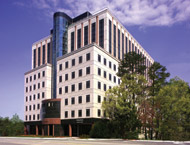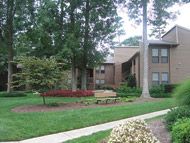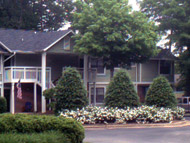|
CITY HIGHLIGHT, JANUARY 2011
RALEIGH CITY HIGHLIGHTS
Mike Lewis, Daniel Eller & Abbitt Goodwin
Raleigh Industrial Market
The Raleigh-Durham industrial market could best be described as stable in 2010. Vacancy rates have fallen to 13 percent, and there is almost no product under construction. It appears that most of the fallout from suppliers to the homebuilding industry is over, and, therefore, fewer companies are giving space back to the market. There may not be too many major leases being signed, but even small deals contribute to lowering the vacancy rate. Other than the two large institutional transactions, sales have been small businesses with cash buying properties at below replacement cost.
Earlier this year saw two major announcements. Caterpillar announced plans to expand its Sanford Building Construction Products campus. Cassidy Turley arranged the build-to-suit deal, which will include the construction of a new 277,000-square-foot distribution and fabrications facility. Panattoni Development Company is serving as the developer for the project, which will be complete by the summer.
In addition, Meredia Development Group sold an 182,165-square-foot building located at 4400 Emperor Blvd. to Crown Realty of Irvine, California — a deal that was also brokered by Cassidy Turley. Prior to the sale, Phoenix Telecom signed a lease for the entire building, making it the largest direct industrial lease in the market in 2010. Crown Realty had also sold a 450,000-square-foot warehouse in the same industrial park to EMC Corp in October 2009 and essentially reinvested in the Raleigh market.
Some of the other large 2010 industrial leases include:
• Syngenta Biotechnology signed for 100,000 square feet in Keystone Industrial Park in Durham;
• Atlas Box and Crating Co. also signed for 62,400 square feet in Keystone Industrial Park;
• Raleigh Offset Inc. signed for 53,000 square feet at Keystone Industrial Park;
• Maine Plastics signed for 60,000 square feet at 2080 E Williams St. in Apex.
The largest sale of 2010 was the 1.53 million-square-foot Research Tri-Center, which was purchased by Northwoods Investors LLC from Grosvenor Investment Management. Sale price for the 88 percent occupied park was $76.95 million.
Consistent with other years, the majority of the industrial activity took place around the Research Triangle Park (RTP). This is historically the most active submarket and contains the most modern industrial space in the marketplace. The majority of the tenant mix for the area continues to be high-tech, government/education, and trade/shipping. Rental rates range from $3.50 NNN on older, less modern product to $4.75 NNN on newer buildings. Due to tightening vacancy, institutional owners have increased asking rates, and in some cases have crossed the $5.00 NNN barrier.
Looking ahead, the Research Triangle Park submarket will continue to dominate quality tenant leasing activity, as it contains the largest amount of institutional-grade product. Expect steady activity and potentially higher rents on Class A product in 2011 due to a lack of availability.
— W. Mike Lewis, CCIM, SIOR, is the president of Raleigh-based The Lewis Group/CORFAC International.
Raleigh Office Market
When the year-end numbers for the Raleigh-Durham office market are compiled, it is predicted the market will have finished 2010 with a small amount of positive absorption. While this may not seem like big news, it counts as a major win for the market.
“Overall, we’re thankful it didn’t get worse this year, but 2007 through 2009 were all years of negative absorption — the longest period of negative absorption in our market’s history,” says Jim Anthony, CEO of Colliers International Raleigh-Durham | Eastern North Carolina. “For 2010, being flat is a victory.”
According to Cassidy Turley’s third quarter office report, overall absorption for the Triangle office market stood at negative 102,499 square feet at the end of the third quarter and a positive 56,725 square feet year to date. The Class B and C markets are struggling most, as tenants take advantage of low rental rates to upgrade to Class A space. Due to this, Class A office product is seeing 14,654 square feet of positive absorption for the third quarter and 213,876 square feet of positive absorption year to date. The health of the area’s submarkets varies greatly.
“Without a doubt, downtown Raleigh is the healthiest of our submarkets,” Anthony says. This is backed up by Cassidy Turley’s third quarter numbers, which show a 9.9 percent vacancy rate and year-to-date positive absorption. While it does not have the highest leasing rates, it still has a healthy average asking rent of $22 for Class A product.
Central Durham is also faring very well, posting an 8 percent vacancy rate and average asking rent of $23.15 for Class A product according to Cassidy Turley’s report. West Raleigh has a higher vacancy rate (13.9 percent), but the submarket has posted the highest absorption in the market for the third quarter (136,914 square feet) and year to date (254,108 square feet).
“The sickest market, by far, is the Research Triangle Park market,” Anthony says. “Huge corporate layoffs and business shrinkage during the last 3 or 4 years have taken a terrible toll on landlords and property owners. The market in RTP never fully recovered from the tech collapse in 2000.”
The RTP market posted a third-quarter vacancy rate of 26.8 percent. It leads all submarkets in negative absorption for the third quarter (-224,718 square feet) and the year (-154,837 square feet). Average asking rates have fallen to $19.75 for Class A product.
However, there is some good news coming out of the market. The third quarter saw Fidelity Investments take 220,000 square feet at Network Center and Talecris Biotherapeutics renew its lease for 163,000 square feet at Research Commons. Advanced Liquid Logic leased 22,599 square feet at 615 Davis Drive in a deal that was brokered by Cassidy Turley. The broker also completed a lease in the Cary submarket in which Wake Technical Community College took 49,297 square feet at 3434 Kildaire Farm Road.
“Tenant leasing activity seems to be improving in various categories — small tenant leasing is clearly on the rise right now,” Anthony says. “Most of that is from small businesses that are either expanding or coming out of their living rooms.”
 |
Hock Plaza in Durham was purchased by Hines Global REIT in the third quarter for $98.3 million.
|
|
However, leasing is almost all of the current activity. New construction has been nonexistent for a few years, according to Anthony. Acquisition activity has been slow, but the past couple of months have seen one of the year’s more notable deals. Hines Global REIT closed on its $98.3 million acquisition of Hock Plaza in Durham. The trophy tower totals 327,160 square feet and is primarily tenanted by Duke University and its healthcare system. The deal reportedly closed at a cap rate under 7 percent.
“[This deal] is a classic example of the trophy properties being treasured, and the under-leased properties that have debt or vacancy problems being trashed,” Anthony says. “There is a big spread in cap rates between those properties.”
Anthony believes the market for distressed and troubled properties will pick up in 2011 and really gain momentum in 2012, as debt financed during the height of the real estate bubble comes to term and some properties fail to find refinancing. There are also some big deals circling the market, including Red Hat, which could kickstart the market in early 2011. After several years of bad news, there could be room for cautious optimism entering into the new year.
— Coleman Wood
Raleigh Multifamily Market
 |
A partnership between TRECAP Partners and Robinson Development Group purchased Stonehenge Apartments for $38 million. The 452-unit property is located in Raleigh.
|
|
With 12 months of hindsight, most industry experts are in agreement that the clear turning point in which the multifamily industry shifted from “downturn” to “recovery” occurred in January 2010. Indisputably, the sales volume within the multifamily asset class increased tremendously in January after surviving 18 months of very little activity.
Two notable deals that closed in the month of December both happened in Raleigh. First, a joint venture between Philadelphia-based TRECAP Partners and local developer Robinson Development Group purchased the 452-unit Stonehenge Apartments for $38 million. The community was strong — as reflected by the sale price — with a 95 percent occupancy rate at the time of closing.
In the Six Forks Road submarket, Holliday Fenoglio Fowler helped brokerd the sale of Riverwoods Apartments for $10 million. Grubb Properties purchased the property from The Dilweg Companies, which has been divesting its multifamily holdings.
 |
Grubb Properties acquired Riverwoods Apartments from The Dilweg Companies for $10 million. The community is located on Six Forks Road in Raleigh.
|
|
To a certain extent this increase in transaction volume is due to the fact that after nearly two years of extreme caution (or in some cases lengthy vacations) by the providers of both debt and equity, all participants in the transaction process were simply eager to get back to work and were ready to make deals.
Many investors entered 2010 with the hope of acquiring distressed assets from lenders at bargain prices. Most investors were looking for assets in “A” locations, low prices per unit, high cap rates, and, ideally, they wanted financing offered by the seller. While a few of these opportunities did materialize during 2010 (typically through an off-market transaction or a note acquisition), most investors looking for this type of opportunity were greatly disappointed.
In Raleigh/Durham, the disappointment was even greater due to the competitiveness and stability of the marketplace. Unlike the early 1990’s, when deeply discounted assets were sold to a handful of groups with the ability to buy, in 2010 almost every multifamily investment offering in Raleigh/Durham has received thirty or more offers and competition has driven pricing up and cap rates down. As an example, cap rates for institutional quality assets have decreased to about 5 percent during the last 12 months.
The Raleigh-Durham market currently has the strongest fundamentals of all of the major markets in the Southeast. These fundamentals include the region’s exponential population growth, average occupancy that never dropped below 90 percent (and that has rebounded very quickly in 2010 to about 93.5 percent through the end of the third quarter), effective rents that have increased approximately 3.5 percent through the end of the third quarter, and most importantly, due to the diversity and strength of the employment sector, an unemployment rate that is below both national and state averages.
Due to the strength of the region and its rapid recovery, any multifamily developer that is easing back into the market has Raleigh-Durham at the top of its wish list. The market suffered from overbuilding before the recession, but the credit freeze during the last few years has allowed absorption to catch up with new construction. Throughout 2010, developers have started to close on multifamily land acquisitions, and projects that were on hold have found new life. Additionally, there are many projects that are in the feasibility phase of the pipeline that have not yet surfaced in most industry reports.
The submarkets that have felt that greatest interest from developers are Chapel Hill, South Durham, the RTP/Interstate 40 Corridor, the Duke University area, North Raleigh and areas inside the Beltline. The most notable projects recent projects are The Tribute, 359 units in North Raleigh near Crabtree Valley Mall, which was delivered ahead of the curve in March 2010 by United Dominion Realty Trust; Trinity Commons, a 342 unit LEED certified community built by Crosland near Duke University and Duke Medical Center in Durham; and Meridian at Wakefield, 369 units under construction by NorthLand Partners in the Wakefield area of North Raleigh. In addition to these early projects, there are many other new developments in the pipeline and a large number of developers that are targeting the region.
In 2011, we will see an increased number of multifamily land acquisitions, more groundbreakings and a multifamily marketplace that is more comparable to 2006 than 2009.
— Daniel Eller runs the Chapel Hill office of Southeast Apartment Partners and covers the North and South Carolina region.
Raleigh Retail Market
The retail market in the Raleigh-Durham-Chapel Hill MSA (“The Triangle”) is steadily improving. Retail vacancy dropped to 8.39 percent within the Triangle as of the third quarter — the result approximately 525,000 square feet in absorption over the past 12 months. Investors and retailers alike continue to be attracted to the region because of its sustainable economy fueled by the state government, Research Triangle Park and the University system.
Several new anchor retailers entered the Triangle market during 2010, absorbing the majority of available boxes abandoned by Circuit City and Linens ‘N Things. Nordstrom Rack filled the former Linens ‘N Things space at CBL’s Renaissance Center at Southpoint in Durham; Ollie’s Bargain Outlet opened at York Properties’ Cary Village Square in Cary; The Container Store made its Triangle debut in the former Circuit City location on Glenwood Avenue across from Crabtree Valley Mall in Raleigh; and buybuy BABY opened its first Triangle location at Kimco’s New Hope Commons in Durham.
Only a small amount of new retail development was completed in 2010. Kane Realty delivered the only anchored retail project at North Hills East, which is situated at Six Forks Road and Interstate 440 — Raleigh’s “Beltline”. Anchored by Harris Teeter and Sparians Bowling Boutique and Bistro, the 96,400-square-foot neighborhood center is 95 percent leased and occupied.
However, increased development activity is expected in 2011 with four new retail centers slated for completion. All of these projects were planned prior to the economic recession and are currently under construction.
Developed by Regency Centers and Welcor Development, The Market at Colonnade will feature the first newly constructed Whole Foods in North Carolina. The 57,000-square-foot neighborhood center is located in the heart of North Raleigh at the intersection of Six Forks and Strickland roads. Upon its completion in early 2011, the development will be the city’s only LEED-certified retail project. The development duo is also completing Harris Crossing, a 52,000-square-foot neighborhood center anchored by Harris Teeter. Located in Wake Forest, NC; the shopping center is slated to open in February.
Phase I of Park West Village is also under construction. Developed by Casto and 1st Carolina Properties, the 304,000-square-foot retail center is expected to feature Target, TJ Maxx and buybuy BABY. Situated at Cary Parkway and Highway 54 in Morrisville, the 100-acre, mixed-use, lifestyle development will include retail, residential, office and entertainment components. Also developed by Casto, Fairview Shopping Center, a Food Lion-anchored neighborhood center is slated to open in January in Cary.
Western Wake County is the next frontier for retail in the Triangle, primarily due to the construction of Interstate 540, Raleigh’s “Outer Loop,” which will go from Research Triangle Park to Highway 55 in Apex. This 12-mile stretch, known as the “Western Wake Expressway,” will improve regional access to Research Triangle Park as well as Raleigh-Durham International Airport for residents of western and southwestern Wake County. Slated for completion in 2012, the improved infrastructure will perpetuate additional demand for community and regional shopping destinations along the Highway 55 corridor.
The Triangle will continue to improve as retailer demand outpaces supply. Inevitably, this demand will pressure developers to deliver new product in 2011 and beyond.
—Abbitt Goodwin manages the Raleigh office The Shopping Center Group’s Carolinas Division.
©2011 France Publications, Inc. Duplication
or reproduction of this article not permitted without authorization
from France Publications, Inc. For information on reprints
of this article contact Barbara
Sherer at (630) 554-6054.
|
